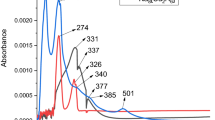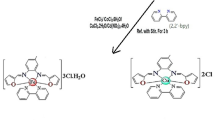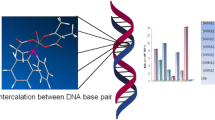Abstract
A series of ternary copper(II) complexes have been derived using ciprofloxacin and four terpyridine derivatives. Complexes were characterized using metal estimation, IR spectroscopy, FAB-mass spectrometry and reflectance spectra. Compounds were screened for their in vitro antimicrobial activity against gram(+ve) and gram(−ve) bacterial species. Binding behaviour of the complexes towards DNA were determined using UV–Vis absorption titration, viscometric and DNA thermal denaturation experiment, where as the cleavage efficacy of the complexes towards pUC19 DNA was determined by gel electrophoresis in the presence of ethidium bromide. The catalytic activity of the copper(II) complexes towards the superoxide anion (O •−2 ) dismutation was assayed by their ability to inhibit the reduction of nitroblue tetrazolium.









Similar content being viewed by others
References
Agrawal KC, Santorelli AC (1978) Relationship between structure and antineoplastic activity of arylsulfonylhydrazones of 2-formylpyridine N-oxide. J Med Chem 21:218–221
Alexious M, Tsivikas I, Dendreinou-Samara C, Pantazaki AA, Trikalitis P, Lalioti N, Kyriakidis DA, Kessissoglou DP (2003) High nuclearity nickel compounds with three, four or five metal atoms showing antibacterial activity. J Inorg Biochem 93:256–264
Anthroline WE, Knight JM, Petering DH (1977) Some properties of copper and zinc complexes of 2-formylpyridine thiosemicarbazone. Inorg Chem 16:569–574
Barton JK, Raphael AL (1984) Photoactivated stereospecific cleavage of double-helical DNA by Cobalt(III) complexes. J Am Chem Soc 106:2466–2468
Barton JK, Raphael AL (1985) Site-specific cleavage of left-handed DNA in pBR322 by lambda-tris(diphenylphenanthroline)cobalt(III). Proc Natl Acad Sci USA 82:6460–6464
Basili S, Bergen A, Dall’Acqua F, Faccio A, Ranzhan A, Ihmels H, Moro S, Viola G (2007) Relationship between the structure and the DNA binding properties of diazoniapolycyclic duplex- and triplex-DNA binders: efficiency, selectivity, and binding mode. Biochemistry 46:12721–12736
Bhirud RG, Srivastava TS (1991) Synthesis, characterization and superoxide dismutase activity of some ternary Copper(II) dipeptide-2,2′-bipyridine, 1,10-phenanthroline and 2,9-dimethyl-1,10-phenanthroline complexes. Inorg Chim Acta 179:125–131
Chaires JB, Dattagupta N, Crothers DM (1982) Studies on interaction of anthracycline antibiotics and deoxyribonucleic acid: equilibrium binding studies on the interaction of daunomycin with deoxyribonucleic acid. Biochemistry 21:3933–3940
Chan S, Wong WT (1995) Ruthenium 1992. Coord Chem Rev 138:219–296
Chohan ZH, Suparan CT, Scozzafava A (2005) Metal binding and antibacterial activity of ciprofloxacin complexes. J Enz Inhi Med Chem 21:303–307
Cohen G, Eisenberg H (1969) Viscosity and sedimentation study of sonicated DNA–proflavine complexes. Biopolymers 8:45–55
Cotton FA, Wilkinson G (1988) Advanced inorganic chemistry, 5th edn. Wiley, New York
Dendrinou-Samara C, Psomas G, Raptopoulou CP, Kessissoglou DP (2001) Copper(II) complexes with phenoxyalkanoic acids and nitrogen donor heterocyclic ligands: structure and bioactivity. J Inorg Biochem 83:7–16
Efthimiadou EK, Thomadaki H, Sanakis Y, Raptopoulou CP, Katsaros N, Scorilas A, Karaliota A, Psomas G (2007a) Structure and biological properties of the Copper(II) complex with the quinolone antibacterial drug N-propyl-norfloxacin and 2,2′-bipyridine. J Inorg Biochem 101:64–73
Efthimiadou EK, Katsaros N, Scorilas A, Karaliota A, Psomas G (2007b) Mononuclear Copper(II) complexes with quinolones and nitrogen-donor heterocyclic ligands: synthesis, characterization, biological activity and interaction with DNA. Inorg Chem Acta 360:4092–4102
Erkkila KE, Odom DT, Barton JK (1999) Recognition and reaction of metallointercalators with DNA. Chem Rev 99:2777–2795
Figgis BN, Lewis J (1960) Modern coordination chemistry: principles and methods. In: Lewis J, Wilkins RG (eds) Willey Interscience, New York
Freedman HH (1961) Intramolecular H-bonds. A spectroscopic study of the hydrogen bond between hydroxyl and nitrogen. J Am Chem Soc 83:2900–2905
Hertzberg RP, Dervan PB (1982) Cleavage of double helical DNA by methidium-propyl-EDTA-iron(II). J Am Chem Soc 104:313–315
Hirohama T, Karunuki Y, Ebina E, Arii H, Suzaki T, Chikira M, Selvi PT, Palaniandavar M (2005) Copper(II) complexes of 1,10-phenanthroline-derived ligands: studies on DNA binding properties and nuclease activity. J Inorg Biochem 99:1205
Hong X-L, Liu Y-J, Tan L-F, Ji L-N (2004) DNA interactions of Cobalt(III) mixed-polypyridyl complexes containing asymmetric ligands. J Inorg Biochem 98:1143–1150
Jin L, Yang P (1997) Synthesis and DNA binding studies of cobalt (III) mixed-polypyridyl complex. J Inorg Biochem 68:79–83
Jones DH, Slack R, Squires S, Wooldrige KRH (1965) Antiviral chemotherapy. I. The activity of pyridine and quinoline derivatives against neurovaccinia in mice. J Med Chem 8:676–680
Katsaros ME, Efthimiadou EK, Psomas G, Karaliota A (2008) Novel Copper(ii) complex of n-propyl-norfloxacin and 1,10-phenanthroline with enhanced antileukemic and DNA nuclease activities. J Med Chem 51:470–478
Klayman DL, Sconill JP, Bafosevich JF, Bruce J (1983) 2-Acetylpyridine thiosemicarbazones. 5. 1-[1-(2-Pyridyl)ethyl]-3-thiosemicarbazides as potential antimalarial agents. J Med Chem 26:35–39
Krotz AH, Kuo LY, Shields TP, Barton JK (1993) DNA recognition by Rhodium(III) polyamine intercalators: considerations of hydrogen bonding and Van der Waals interactions. J Am Chem Soc 115:3877–3882
Kumar RS, Arunachalam S, Periasamy VS, Preethy CP, Riyasdeen A, Akbarsha MA (2008) DNA binding and biological studies of some novel water-soluble polymer–Copper(II)–phenanthroline complexes. Euro J Med Chem 43:2082–2088
Le Pecq JB, Paoletti C (1967) A fluorescent complex between ethidium bromide and nucleic acids. J Mol Biol 27:87
Li J-H, Wang J-T, Mao Z-W, Ji L-N (2008) Structure, speciation, DNA binding and nuclease activity of two bipyridyl-zinc complexes bearing trimethylaminomethyl groups. Inorg Chem Commun 11:865
Liang F, Wang P, Zhou X, Li T, Li ZY, Lin HK, Gao DZ, Zheng CY, Wu CT (2004) Nickle(II) and cobalt(II) complexes of hydroxyl-substituted triazamacrocyclic ligand as potential antitumor agents. Bioorg Med Chem Lett 14:1901–1904
Long EC, Barton JK (1990) On demonstrating DNA intercalation. Acc Chem Res 23:271
Morehouse SN, Suliman H, Haff J, Nguyen D (2000) The structure and electrochemistry of imidazolebis(1–10 phenanthroline)copper(II) nitrate. Inorg Chim Acta 297:411–416
Mudasir YoshiokaN, Inoue H (1999) DNA binding of Iron(II) mixed-ligand complexes containing 1,10-phenanthroline and 4,7-diphenyl-1,10-phenanthroline. J Inorg Biochem 77:239–247
Nakamoto K (1986) Infrared and Raman spectra of inorganic and coordination compounds, 4th edn. Wiley Interscience Publication, New York
Naso L, Baró ACG, Lezama L, Rojo T, Williams PAM, Ferrer EG (2009) Synthesis, chemical speciation and SOD mimic assays of tricarballylic acid–copper(II) and imidazole–tricarballylic acid–copper(II) complexes. J Inorg Biochem 103:219–226
Patel R (1974) Molecular spectroscopy: theory and applications. SP University press, Vallabh Vidyanagar
Patel MN, Chhasatia MR, Gandhi DS (2009) DNA-interaction and in vitro antimicrobial studies of some mixed-ligand complexes of Cobalt(II) with fluoroquinolone antibacterial agent ciprofloxacin and some neutral bidentate ligands. Bioorg Med Chem Lett 19:2870–2873
Ponti V, Dianzaini MU, Cheesoman K, Stater TF (1978) Studies on the reduction of nitroblue tetrazolium chloride mediated through the action of NADH and phenazine methosulphate. Chem Biol Inter 23:281–291
Reichmann ME, Rice SA, Thomas CA, Doty P (1954) A further examination of the molecular weight and size of desoxypentose nucleic acid. J Am Chem Soc 76:3047–3053
Ren J, Chaires JB (1999) Sequence and structural selectivity of nucleic acid binding ligands. Biochemistry 38:16067–16075
Roberts NA, Robinson PA (1985) Copper chelates of antirheumatic and anti-inflammatory agents: their superoxide dismutase-like activity and stability. Brit J Rheumatol 24:128
Russell AD (1991) Principles of antimicrobial activity. In: Block SS (ed) Disinfection, sterilization and preservation, 4th edn. Lea and Febinger, Philadelphia, pp 27–59
Selvi PT, Evans HS, Palaniandavar M (2005) Synthesis, structure and DNA interaction of cobalt(III) bis-complexes of 1,3-bis(2-pyridylimino)isoindoline and 1,4,7-triazacyclononane. J Inorg Biochem 99:2110–2118
Sherman SE, Lippard SJ (1987) Structural aspects of platinum anticancer drug interactions with DNA. Chem Rev 87:1153–1181
Shields TP, Barton JK (1995) Sequence-selective DNA recognition and photocleavage: a comparison of enantiomers of Rh(en)2phi3+. Biochemistry 34:15037–15048
Singh OI, Damayanti M, Singh NR, Singh RKH, Mohapatra M, Kadam RM (2005) Synthesis, EPR and biological activities of bis(1-n-butylamidino-O-alkylurea)copper(II)chloride complexes: EPR evidence for binuclear complexes in frozen DMF solution. Polyhedron 24:909–916
Sitlani AS, Long EC, Pyle AM, Barton JK (1992) DNA photocleavage by phenanthrenequinone diimine complexes of Rhodium(III): shape-selective recognition and reaction. J Am Chem Soc 114:2303–2312
Trommel JS, Marzilli LG (2001) Synthesis and DNA binding of novel water-soluble cationic methylcobalt porphyrins. Inorg Chem 40:4374–4383
Urquiola C, Gambino D, Cabrera M, Lavaggi ML, Cerecetto H, Gonzalez M, Lopez de Cerain A, Antonio M, Antonio JC-F, Maria HT (2008) New copper-based complexes with quinoxaline N1,N4-dioxide derivatives, potential antitumoral agents. J Inorg Biochem 102:119
Vogel AI (1978) Textbook of quantitative inorganic analysis, 4th edn. ELBS and Longman, London
Wolfe A, Shimer GH, Meehan T (1987) Polycyclic aromatic hydrocarbons physically intercalate into duplex regions of denatured DNA. Biochemistry 26:6392–6396
Yang J, Wong RN-S, Yang MS (2000) Protective mechanism of metallothionein against copper–1,10-phenanthroline induced DNA cleavage. Chem Biolog Inter 125:221–238
Zelenko O, Gallagher J, Xu Y, Sigman DS (1998) Chemical nuclease activity of 1,10-Phenanthroline–Copper. Isotopic probes of mechanism. Inorg Chem 37:2198–2204
Acknowledgments
Authors thank Head, Department of Chemistry, Sardar Patel University, India for making it convenient to work in laboratory and U.G.C. for providing financial support under “UGC Research Fellowship for Meritorious Students” scheme.
Conflict of interest
The authors report no conflicts of interest. The authors alone are responsible for the content and writing of the article.
Author information
Authors and Affiliations
Corresponding author
Rights and permissions
About this article
Cite this article
Patel, M.N., Dosi, P.A. & Bhatt, B.S. Synthesis, characterization, antibacterial activity and DNA interaction studies of drug-based mixed ligand copper(II) complexes with terpyridines. Med Chem Res 21, 2723–2733 (2012). https://doi.org/10.1007/s00044-011-9799-6
Received:
Accepted:
Published:
Issue Date:
DOI: https://doi.org/10.1007/s00044-011-9799-6




